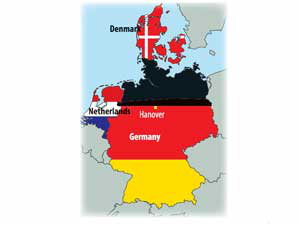Chances and risks for German pig production

On the eve of the largest EuroTier ever, Germany has grown to become the undisputed market leader in swine production in Europe. Germany has had only growth figures since about 2005. With plenty of challenges ahead for the swine industry, will the country be able to retain this leading position in the decades to come?
By Hans-Wilhelm Windhorst, professor emeritus for comparative structural analysis, Institute for Spatial Analysis and Planning in Areas of Intensive Agriculture (ISPA), University of Vechta, Germany
Until 2005, Germany had a negative balance of trade with pig meat. Within a few years the situation changed completely, Germany has now become one of the leading pig meat exporting countries and in 2011 surpassed the Netherlands, Denmark and even the USA. On one hand this documents shows the competitiveness of the German pig farmers and the leading packers, on the other hand, it shows how much the dependence on the volatility of the global market has increased.
This article aims to document the main driving factors behind the remarkable dynamics and analyse the chances and risks of the German swine industry in a global market for pork.
Leading position in the EU
In 2011, Germany contributed 24% to total pig meat production in the European Union (see Table 1). Over the past years, this position could be fastened because of a continuous increase in the number of slaughtered pigs. Of the 59.7 million pigs which were slaughtered in 2011, the for leading companies (Tönnies, Vion, Westfleisch and Danish Crown) shared 60%.
The ongoing sectoral concentration is an important steering factor for the success in the global pork market. These companies are able to supply the EU and non-EU countries with high quality pig meat for a competitive price. One major reason for the low prices which these companies can offer is the comparatively low labour costs. However, the employment of a low wage labour force is being discussed and it might happen that this will no longer be possible within a few years.
Exports to non-EU countries
The increase in the production volume resulted in a growing self-sufficiency rate from 96% in 2006 to 115% in 2011. The surplus in the trade with pig meat increased from only 41,000 tonnes in 2005 to 1.4 million tonnes in 2011. Of the 2.8 million tonnes of pork exported in 2011, 28% were sold in non-EU countries (see Table 2), in 2009 it had only been 17%. The leading non-EU countries of destination were Russia with an import volume of almost 299,000 tonnes and Hong Kong with 196,000 tonnes.
Together they shared almost two thirds of the exports to non-EU countries. Besides low prices, the export success is a result of ilateral veterinary trade negotiations between Germany and the importing countries and the comprehensive implementation of the QS-System (Quality and Safety). The growing dependence on exports to countries outside the EU comprises, however, several risks. As Germany has to import large amounts of feed components, one risk is the volatility of the world market for these components.
A second risk is the dependence on only a small number of importing countries outside the EU, especially Russia. Even though Russia may not be able to reach self sufficiency for pig meat within a few years, it can nevertheless be expected that the import volume will decrease considerably. This perspective has definitely been a reason for Tönnies to invest in a vertically integrated production system in Russia.
Growing imports of live pigs
The increase in pig meat production and exports over the past years would not have been possible without considerable imports of piglets and slaughter pigs. Domestic production alone would not have been able to supply the slaughterhouses with a sufficient number of pigs, in particular because of a continuous decrease of the sow population and of piglet production.
Table 3 shows that the imports of piglets, breeding sows and boars had only a small share, increased from 2.7 million in 2000 to almost 9 million in 2010. The data for 2011 are preliminary, but it can be expected that close to 9 million piglets were also imported last year. About two thirds of the imported piglets came from Denmark and one third from the Netherlands. All other countries were only of minor importance. Most of the piglets were purchased by pig farmers in north western Germany, the centre of the German swine industry. Without these piglets farmers would not have been able to fill their finishing places. And without the pigs, stemming from these piglets, the slaughterhouses would not have been able to use their installed capacity. A reduction of the imports because of the EU directive 2001/88/EU which from 2013 on demands the keeping of sows from the fourth week after gestation until one week before farrowing in groups could easily lead to a shortage of piglets, as a decreasing number of sows in Denmark and the Netherlands is expected.
Over 5 million slaughter pigs were imported in 2010 in addition to the piglets, of which 80% came from the Netherlands (Table 4). Although the data for 2011 are preliminary, a considerable reduction of the imports from Denmark is obvious. Because of the narrowing gap between market prices for hogs in Denmark and Germany, many Danish pig farmers decided to sell their pigs to Danish slaughter companies. If this trend should continue, a shortage of slaughter pigs may be the case in 2012. In August 2012, there was a high demand for slaughter pigs in EU member countries in Eastern Europe which led to a price increase and a growing willingness of pig farmers in southern Germany to sell their pigs to buyers in these countries.
Sectoral concentration will continue
In a comprehensive study dealing with the competitiveness of German pig production, Aline Veauthier (2010) presented a projection for the development of the German swine industry until 2020. From the data in Table 5 one can see that a sharp reduction of the number of pig farms is expected. In contrast to slaughter pigs, the number of breeding pigs will further decrease and add to the already existing shortage of piglets. This may develop to a serious problem for fattening farms and slaughterhouses if no new sources for piglet and pig imports can be found.
Perspectives
The preceding analysis could show that the success of the German pig industry was made possible by very efficient pig farms in Germany, high imports of piglets and slaughter pigs from Denmark and the Netherlands, the nationwide implementation of the QS-System, trade negotiations with the leading importing countries of German pork and a consolidation process in the slaughter and further processing industry.
The success story, which started in 2005, also bears several risks. The main risks are the dependence on imports of large amounts of feed and live pigs, on low wages in the slaughterhouses and on only a few importing countries outside the EU. Other factors which may become more and more important in north western Germany in the near future are environmental and disease problems in the centres of pig production as well as a growing opposition against the construction of new large pig farms. In addition, animal welfare topics may also slow down the dynamics of the past years.
EUROTIER 2012 LARGER THAN EVER
Four days of show may not even be enough for this year’s visitors of EuroTier, held in Hanover, Germany, from 13-16 November. The 2012 edition of Europe’s most extensive livestock event promises to be the largest and most international edition ever. Apart from a record number of exhibitors, there will be plenty of attention for animal welfare as well as a special zoom on farrowing units. At least 2,336 exhibitors from 51 countries have booked exhibition space, to be held at Hanover’s Exhibition Grounds. With 250,000 m2 of exhibition space, the show has grown by more than 30% since its last edition in 2010. The international contingent at the biennial show will be over 1,000 exhibitors, which is a 25% increase in comparison to the 2010 edition. This means that nearly half of the exhibitors will come from outside Germany. The Netherlands again leads the field with 193 companies. Strong exhibitor participation will also come from France (139), China (97), Italy (90), Denmark (85), Spain (68), United Kingdom (64), Austria (57), Belgium (55) and the USA (40). The show will address the pig, cattle and poultry sectors, with every possible leading company in the field of genetics, housing, climate control, animal health, nutrition and feed additives. In addition, attention for bioenergy with also be available at he ‘BioEnergy Decentral’ show. Highlighting innovations, an independent jury will be awarding gold and silver medals. In total, 160,000 visitors are expected in Hanover.
Farrowing units Gestation crates are still being replaced throughout the European Union, but at EuroTier the next dimension of animal welfare shall already be highlighted: that of farrowing units. A special theme, Animal Health in Farrowing Units’ Special, will focus on the latest developments for modern and resource-conserving piglet production. Various options for piggery construction, installations and facilities, floor design, climate control, and hygiene and health management will be shown by way of example in Hall 11. Alongside conventional methods, alternative forms of keeping that give sows greater freedom of movement will be shown. More animal welfare related information can be found in the Animal Welfare Info Centre. This is opened to offer open discussion sessions on socially critical priority topics. Two discussion panels will be held daily following the round table principle. The discussion sessions will be chaired professionally and feature experts representing opposite positions on the various topics. These discussion events will be supplemented by information islands on the subject of animal welfare in animal husbandry and management. Also new is a special Feed Gallery. Visitors will be able to see the variety and broad base of the raw materials (feed materials) for animal husbandry.
Side events Apart from the show and its specials, EuroTier presents an extensive technical programme – with for example the EuroTier International Pig Event being held in the Convention Centre on November 12, the day prior to the onset of the show. With cooperation of the Chinese Animal Agriculture Association (CAAA), the Pig Event will provide a platform for European as well as Chinese pig farmers to meet and greet. Main theme of this event is ‘Europe: between export continent America and import continent Asia – Perspectives for the global pork market’. One day later, the traditional Eastern European Conference will examine the prospects and challenges of animal production in the CIS countries. Other side events will include the Young Farmers Day; the ‘TopTierTreff’ for the best dairy cows and cattle; an Aquaculture Forum; and the congress of the German Federal Association of Practising Veterinarians. A preview of some innovations at EuroTier 2012 can be found on pages 48-49. The Pig Cough Monitor (pages 34-35) is also presented at EuroTier. |
References available on request







